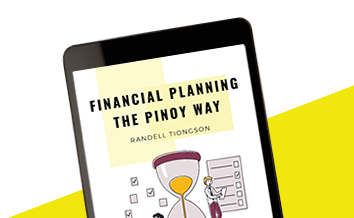Stocks or Stock Funds?
By Randell Tiongson on February 9th, 2015
 QUESTION: I am ready to start investing and I would like to invest in equities. Is it better to invest in stocks directly or through pooled stock funds like UITF or mutual funds? —Name withheld per request, asked via e-mail
QUESTION: I am ready to start investing and I would like to invest in equities. Is it better to invest in stocks directly or through pooled stock funds like UITF or mutual funds? —Name withheld per request, asked via e-mail
Answer: As a financial and investment planner, we need to subscribe to the principle of suitability. Without sufficient information, it wouldn’t be prudent of me to categorically say one would be better than the other. The answer really depends on you—if you are knowledgeable enough to select your own stocks, size of funds, and if you have enough time for investing.
However, to help you make a more informed decision, let’s discuss the advantages and disadvantages of both types of investing.
On individual stocks
Advantages :
Control—Buying your stocks directly gives you control over what and when to buy or sell.
Residual income—If you buy a stock with a good dividend payout, then you don’t have to watch the price movement anymore. As long as the company is earning and declares dividends, you will get dividends.
Maximized returns—individual stocks that are growing may beat the market and can give you better-than-average returns. Many stocks beat the index last year.
Potentially better returns—with proper selection and assuming that you are very good at selecting market performers, the growth of your own stock portfolio can outperform the stock market index and many stock funds.
Fees—buying your stocks directly from brokers usually means lower fees as fund managers charge a higher investment management fee compared to stock brokers.
Disadvantages :
Time-consuming—before investing, you should spend enough time thoroughly understanding how stock market investing works. You should also accumulate enough knowledge of both fundamental and technical analysis. Fundamental analysis means you must be able to read and understand financial reports of the companies you would like to invest in, the general condition of the industries and market trends to which these companies belong to, general knowledge of macroeconomics and even the management of the corporations you would like to own shares of, etc. Technical analysis will require you to constantly study charts on price averages, trading volumes and a multitude of technical market theories like Dow theory, Relative Strength Index, Elliott Wave theory and more. While fundamental and technical analysis is not rocket science, it takes considerable time for you to learn them properly. Enrolling in a class like Marvin Germo’s Stock Smarts is a good way to start.
Diversification—all investment professionals will always recommend you to diversify. No amount of study and good performance in the past will guarantee the performance of a particular stock in the future so having several and properly selected stocks is always a prudent thing to do. Unless you have a very big capital for investing, you will be limited to the variety of stocks you can carry in your portfolio.
On stock funds
Advantages :
Professional fund management—this is perhaps the biggest advantage of pooled funds like UITFs and mutual funds. There is a dedicated team of investment experts that looks at investment opportunities and is investing the money according to the investment objectives of the fund. It is common to see CFAs or Certified Financial Analysts leading or being part of these investment teams. Good fund managers are clinical and logical investors and are not easily swayed by emotions as compared to individual investors.
Capital requirements—most of pooled stock funds have low capital entry requirements. One can invest in a fund for as low as P 5,000 to P10,000, with other providers requiring a monthly contribution of as low as P1,000 per month.
Diversification—all stock funds carry well-diversified stocks in their portfolio, usually blue chip or premium stocks. Since these are pooled funds, there are economies of scale in place; fund managers will be able to purchase different shares. Proper diversification will ultimately result in reduced portfolio risk.
Disadvantages :
Fees—While not all stock funds charge the same range of fees, these fees are usually much more than broker fees as there are costs involved in managing funds. Some funds even charges entry and exit fees, which can reduce the returns of your investments. Some funds are being sold through agents and advisors and commissions would need to be paid to them.
Control—you have no say on which funds you want or don’t want in your fund as this is already delegated to the fund managers. You also can’t modify the weight of the stocks inside a stock fund as fund managers follow maximum exposure limits per stock to ensure proper risk management practices. Even if you want more PLDT or Jollibee shares in your portfolio, your fund will only have a limited exposure to said stocks, like 10 percent.
The answer to your question is dependent upon you knowing the pros and cons of individual stock investing or through a pooled equity or stock fund. If you are a new investor, I recommend you invest in a stock fund first and as you get to understand how the stock market works and develop your competency in investing, you may want to start investing in individual stocks. There are no perfect investments and there are many ways to build your wealth, chose a strategy that you will be most comfortable with.
Do not forget, whether investing in stocks by yourself or through a fund, it pays to invest first in investment education.
2015 Outlook, part 9
By Randell Tiongson on January 23rd, 2015
Interest rates, heightened geopolitical risks, global growth and many other factors will have an effect on 2015 and yet, Riza Mantaring, the CEO of the country’s number 1 life insurance company (Sun Life) feels that Philippine outlook is still positive. Ms. Mantaring’s company has been in the forefront of getting Filipinos financially abled and she views that there is still a lot to be done.
The 2015 Outlook of Riza Mantaring
Giving an outlook for the year almost seems like a shot in the dark given how wrong most people were last year — equities market expected to be slow in anticipation of higher interest rates and a global slowdown, but the PSEi ended the year up 22.8% and close to its all-time high; US interest rates expected to be up with the end of quantitative easing, but ended the year much lower; Philippine treasuries expected to move past 5% but ended at 4.5%; oil prices hit an all-time high mid-year at $107/barrel but ended at $53, a price not seen in years.
Again, this year, interest rates are expected to move up, and heightened geopolitical risks and global growth dragged by Europe and China may cause some volatility, but for the Philippines, our outlook is quite positive. Abundant liquidity, lower oil prices, and a slightly weaker currency will all contribute to strong domestic consumption. Aside from this, anticipation of election spending and increased government spending on infrastructure and public works can all contribute to higher GDP.
 Riza is a member of the Sun Life Asia Executive Team. She has also participated in various international special projects and teams such as the task force for worldwide restructuring of the company, the task force for business processes, and special teams for Mergers & Acquisitions.
Riza is a member of the Sun Life Asia Executive Team. She has also participated in various international special projects and teams such as the task force for worldwide restructuring of the company, the task force for business processes, and special teams for Mergers & Acquisitions.
In 2010, on the occasion of the 100th anniversary of the University of the Philippines College of Engineering, she was selected one of the 100 Most Outstanding Alumni of the past century. In 2011, she was named by Moneysense Magazine one of the 12 Most Influential in Personal Finance. She is also a recipient of the 2011 CEO EXCEL award given by the International Association of Business Communicators. Riza was recognized for bold and innovative programs anchored on a five year strategy, “Route 5”, and harnessing the power of communication to implement these programs, including the multi-awarded and pioneering “It’s Time!” financial literacy advocacy. The strategies and programs put in place have resulted in unprecedented growth for Sun Life in sales, assets under management, and provincial presence.
In February 2011, the company announced the acquisition of 49% of Grepalife Financial Inc, creating Sun Life Grepa Financial and opening up the bancassurance channel for Sun Life.
Riza graduated with a B.S. Electrical Engineering degree (cum laude) from the University of the Philippines, and an M.S. Computer Science from the State University of New York at Albany. She has also attended numerous executive development programs conducted by Harvard University, The Wharton School, Duke University, Oxford University, Asian Institute of Management, and The Niagara Institute. She is a Fellow of the Life Management Institute (with distinction).
She was a board director of the Philippine Life Insurance Association from 2011-2013, serving as Secretary in 2012 then Treasurer in 2013. She served as a board director of the Philippine Federation of Pre-need Companies from 2006-2008.
Riza also serves as an independent director of Ayala Land Inc., the country’s largest real estate firm, and Microventures Foundation Inc., which runs the Hapinoy social entrepreneurship program.
2015 Outlook, part 7
By Randell Tiongson on January 20th, 2015
In this installation of the 2015 Outlook series, my friend James Lago of the PCCCI once again gives us his highly valuable views on many factors that will affect 2015 — Economic growth, stock market, US dollars, interest rates, liquidity and more. His outlook will be very helpful as to those who are taking a closer look at their portfolios.
The 2015 Outlook of James Lago
Economy – For 2015, our initial GDP growth forecast range is 6.0% – 6.6%. This baseline assumption is premised on the following growth rates of the major industry groups: industry growing by another 6.5%, services expanding by 6.0% and agriculture posting a 2.5% growth. On the expenditures side, we firmly believe that the substantial decline
in energy prices will translate to increased disposable income which in turn will translate to household spending (HFCE) projected to rise by 5.5% – 6.0%.
The major dividend from lower energy prices is lower inflation. Factoring in our anticipated peso-dollar exchange rate this year, our initial average inflation forecast for the year ranges from 2.1% – 2.5% using the 2006 base year.
PSEi – The bullish trend since its recovery in 2009 remains intact. A fresh historic high of 7,413.62 was achieved as the bull market completed its 6th consecutive year last year.
2015 starts with the leading and trailing relative valuations above its historical averages, as well as the regional average again. The lower energy price benefits will certainly be this year’s major driver. Investors are optimistic that the Philippine economy could post a 6.0% GDP growth rate, at least, for this year. Corporate
earnings will most certainly improve as a result of margin improvement and higher volume sales. Our base case scenario for the PSEi this year is a rise to 7,500 – 7,800. Healthy corrections in between is expected and we see the supports at 6,800 and 6,650.
Peso – US dollar – For this year, with the dollar index firmly above the key level of 90, and as funds flow back into US dollar assets, we see the peso probably depreciating to 46.00 or even 47.00. It will result in a 61.8% to 66.0% retracement of its October 2008 – January 2013 appreciation. On the appreciation side, an appreciation to 44.50 or even 44.00 cannot be discounted within the year as the country will continue to attract both FDI and portfolio inflows given its continued growth prospects and its investment grade rating.
dollar assets, we see the peso probably depreciating to 46.00 or even 47.00. It will result in a 61.8% to 66.0% retracement of its October 2008 – January 2013 appreciation. On the appreciation side, an appreciation to 44.50 or even 44.00 cannot be discounted within the year as the country will continue to attract both FDI and portfolio inflows given its continued growth prospects and its investment grade rating.
Domestic Fixed Income Yields – Real returns on the short-term yields remained negative anew in 2014 despite the sell-off in the latter part of the year. The year ended again with a normal yield curve whose steepness was reduced as the spread between the average short and long-term yields narrowed sharply to 160.30 bps, way below its 250 – 300 bps range.
Excess liquidity and portfolio flows into peso-denominated fixed income securities will most likely keep the continued rise of domestic yields gradual overall. The negative real returns on short-term yields in 2014 might not be absurd compared to the past few years. The flattening of the country’s yield curve, a historical first, is a possible scenario. The spread between the average short-term and long-term yields will most likely move within a 200 – 250 bps range within the year as investors will continue to find ways around the yield levels. The yield curve is also seen to remain essentially normal in 2015 with yields in between 2009 and 2012 yield levels.
Portfolio Strategy – Our overall core equity strategy for this year continues to be anchored on the soundness of a firm’s core business model and its stock’s key relative valuations, PER and PBV, trading at a discount to the PSEi’s averages. Cognizant of the benefits of lower energy prices on consumption spending and the fact that consumer-related or proxy stocks’ relative valuation are trading at a premium to the market’s averages, we chose only those whose premiums are reasonable enough to give investors a better upside potential. As a whole, lower energy prices will be beneficial to most firms by way of improved margins and increased volume sales. Several of the stocks in our short list also have attractive, above market average dividend yields.
Given the potential of a near flattening of the country’s yield curve, driven by the normalization of short-term yields and the low inflation scenario, corporates are seen to continue taking advantage of still affordable medium to long-term yields. We continue to encourage investors to take a serious look at the existing PSE-listed preferred
shares and possible new offerings in 2015 as the yields will remain attractive. For fixed income securities, investors will have to be opportunistic again, taking advantage to purchase, when yields touch attractive levels within the year. It is still best to diversify the fixed income portfolio across various tenors to optimize the portfolio yield. The suggested average tenor or duration of the portfolio must be within the short to middle-tenor ranges as yields on the long dated instruments are not attractive for now.
 Joseph James Lago is the Head of the PCCI Securities Brokers Corp. He has over 2 decades of experience in the investments industry in various capacities. He is also a professor of the De La Salle University Graduate School teaching in Management and Economics. He is a much sought after researcher, economist and analysts. He is a Registered Financial Panner.
Joseph James Lago is the Head of the PCCI Securities Brokers Corp. He has over 2 decades of experience in the investments industry in various capacities. He is also a professor of the De La Salle University Graduate School teaching in Management and Economics. He is a much sought after researcher, economist and analysts. He is a Registered Financial Panner.
 QUESTION: I am ready to start investing and I would like to invest in equities. Is it better to invest in stocks directly or through pooled stock funds like UITF or mutual funds? —Name withheld per request, asked via e-mail
QUESTION: I am ready to start investing and I would like to invest in equities. Is it better to invest in stocks directly or through pooled stock funds like UITF or mutual funds? —Name withheld per request, asked via e-mail



